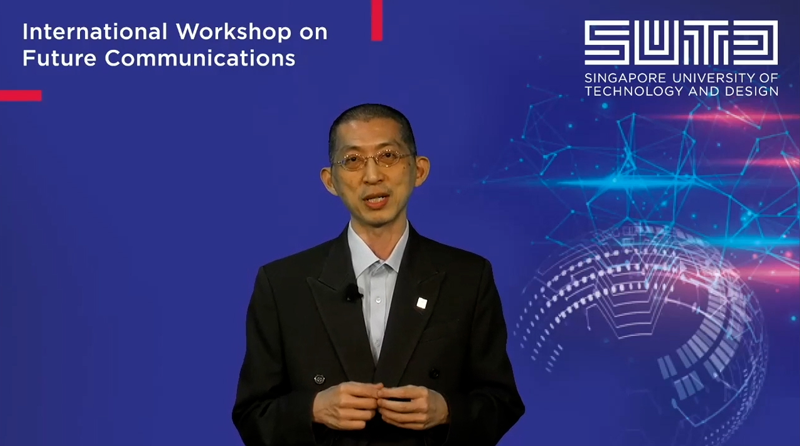6G and beyond: the journey starts now
At the International Workshop on Future Communications, experts emphasised the key role of emerging technologies like 6G in driving a more connected, digitalised world.
With speeds of up to 20-gigabits per second and the ability to support up to one million devices per square kilometre, 5G—the latest generation of mobile communications technology—may already seem impressive, but 6G is set to take these capabilities even further. For instance, with 5G, it would take 3.6 seconds to download a two-hour movie. However, a mindboggling 142 hours of Netflix shows can be downloaded in a single second with 6G.
But even as the country is in the midst of rolling out its nationwide 5G networks, researchers from the Singapore University of Technology and Design (SUTD) and around the world are already looking ahead to a future fueled by 6G and other state-of-the-art communications technologies.
 Prof Yeo Kiat Seng, Associate Provost for Research and International Relations, SUTD, gave the opening address at the workshop.
Prof Yeo Kiat Seng, Associate Provost for Research and International Relations, SUTD, gave the opening address at the workshop.
At the International Workshop on Future Communications, organised by SUTD’s Office of Research on 23 and 24 June 2021, leading scientists across the industry and academe discussed the possibilities offered by emerging technologies. Aside from 6G, other speakers delved into topics ranging from blockchain-empowered Internet of Things (IoT) networks to optimal design frameworks for machine-to-machine communications.
Setting the stage
Beyond ultra-fast streaming, there are several reasons driving the need for 6G, highlighted SUTD’s Professor Tony Quek, Head of the Information Systems Technology and Design pillar, in his talk.
With wireless connectivity becoming increasingly common, there will be more applications like virtual/augmented reality (VR/AR), artificial intelligence (AI) and even autonomous vehicles requiring high data rates combined with extremely low latencies, or delays, due to processing time.
Accordingly, 6G, with its peak data rate of 1 Terabit per second and latency of 100 microseconds, should be able to smoothly support these use cases. At the same time, individuals and organisations will expect a trustworthy network that can seamlessly and securely deliver data—meaning that further research must focus on building a holistic 6G network security architecture.
Moreover, with Singapore working towards the United Nations’ Sustainable Development Goals in 2030, having highly interconnected devices and sensors through 6G could also increase the efficiency and sustainability of processes and services. Indeed, much like how 5G is enabling the widespread application of Internet of Things (IoT), 6G could pave the way for the Internet of Senses (IoS).
While current mobile networks engage two senses—sight and sound—the 6G-powered IoS will rely on AR, VR and AI to expand the spectrum of digital sensory experiences. For instance, 6G’s extremely low latency may realistically recreate tactile sensations that take our bodies milliseconds to register.
Interestingly, IoS might solve the social barriers brought about by the pandemic. “If you are quarantined and have to talk to someone, how do you actually translate this particular emotion? I don’t think 5G can do this,” said Prof Quek.
Prof Quek says that there is much work to be done before 6G becomes a reality. “6G will be commercially available in 2030, but we do not yet have a clear picture of the technology—this is the biggest challenge that all researchers are facing now,” he explained.
Still, the ongoing local roll-out of 5G infrastructure should lay the foundations for 6G efforts. “Each generation takes 10 years to develop,” said Prof Quek. “In order for Singapore to stay ahead and be a leading Smart Nation, we need to invest early in future communications.”
To 6G and beyond
Given Singapore’s Smart Nation ambitions, investing in future communications like 6G places the country at the forefront of the global digital economy—allowing the Republic to provide digital services across Southeast Asia and beyond. “Having that capability would put [Singapore] in a stronger position to be a big part of this whole ecosystem and industry,” said Prof Quek. “The journey to 6G starts now.”
As the fifth-most influential research institution in telecommunications globally, SUTD is set to play a key role in driving future communications research. “The university has a high concentration of faculty researching in AI, 5G, beyond 5G, mm-wave, AR, wireless communications, cybersecurity, edge computing and IoT,” explained Prof Yeo Kiat Seng, SUTD Associate Provost for Research and International Relations during his opening address at the workshop.
To facilitate better interaction among the faculty researching in these areas, SUTD is setting up a mega research centre—bringing together local and international research institutes, universities, industry and agencies as well as providing a testbed for digital innovation and technology translation.
“In our next phase of growth, SUTD will be actively seeking out partners to identify and seize opportunities, leveraging upon our unique value proposition in twinning technology and entrepreneurship in co-advancing innovation,” concluded Prof Yeo. “The future communications workshop will enable SUTD to build new networks to facilitate innovation going forward.”